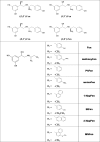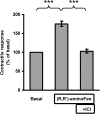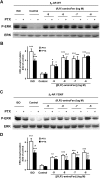Tyrosine 308 is necessary for ligand-directed Gs protein-biased signaling of β2-adrenoceptor
- PMID: 24831005
- PMCID: PMC4094047
- DOI: 10.1074/jbc.M114.558882
Tyrosine 308 is necessary for ligand-directed Gs protein-biased signaling of β2-adrenoceptor
Abstract
Interaction of a given G protein-coupled receptor to multiple different G proteins is a widespread phenomenon. For instance, β2-adrenoceptor (β2-AR) couples dually to Gs and Gi proteins. Previous studies have shown that cAMP-dependent protein kinase (PKA)-mediated phosphorylation of β2-AR causes a switch in receptor coupling from Gs to Gi. More recent studies have demonstrated that phosphorylation of β2-AR by G protein-coupled receptor kinases, particularly GRK2, markedly enhances the Gi coupling. We have previously shown that although most β2-AR agonists cause both Gs and Gi activation, (R,R')-fenoterol preferentially activates β2-AR-Gs signaling. However, the structural basis for this functional selectivity remains elusive. Here, using docking simulation and site-directed mutagenesis, we defined Tyr-308 as the key amino acid residue on β2-AR essential for Gs-biased signaling. Following stimulation with a β2-AR-Gs-biased agonist (R,R')-4'-aminofenoterol, the Gi disruptor pertussis toxin produced no effects on the receptor-mediated ERK phosphorylation in HEK293 cells nor on the contractile response in cardiomyocytes expressing the wild-type β2-AR. Interestingly, Y308F substitution on β2-AR enabled (R,R')-4'-aminofenoterol to activate Gi and to produce these responses in a pertussis toxin-sensitive manner without altering β2-AR phosphorylation by PKA or G protein-coupled receptor kinases. These results indicate that, in addition to the phosphorylation status, the intrinsic structural feature of β2-AR plays a crucial role in the receptor coupling selectivity to G proteins. We conclude that specific interactions between the ligand and the Tyr-308 residue of β2-AR stabilize receptor conformations favoring the receptor-Gs protein coupling and subsequently result in Gs-biased agonism.
Keywords: Adrenergic Receptor; Cardiomyocyte Contraction; Cardiovascular; Functional Selectivity; G Protein-coupled Receptor (GPCR); Molecular Docking; Molecular Pharmacology; Signal Transduction; Site-directed Mutagenesis.
© 2014 by The American Society for Biochemistry and Molecular Biology, Inc.
Figures









Similar articles
-
Heterodimerization With 5-HT2BR Is Indispensable for β2AR-Mediated Cardioprotection.Circ Res. 2021 Jan 22;128(2):262-277. doi: 10.1161/CIRCRESAHA.120.317011. Epub 2020 Nov 19. Circ Res. 2021. PMID: 33208036
-
Norepinephrine- and epinephrine-induced distinct beta2-adrenoceptor signaling is dictated by GRK2 phosphorylation in cardiomyocytes.J Biol Chem. 2008 Jan 25;283(4):1799-807. doi: 10.1074/jbc.M705747200. Epub 2007 Dec 3. J Biol Chem. 2008. PMID: 18056263
-
Stereochemistry of an agonist determines coupling preference of beta2-adrenoceptor to different G proteins in cardiomyocytes.Mol Pharmacol. 2009 Jan;75(1):158-65. doi: 10.1124/mol.108.051078. Epub 2008 Oct 7. Mol Pharmacol. 2009. PMID: 18838481 Free PMC article.
-
Recent advances in cardiac beta(2)-adrenergic signal transduction.Circ Res. 1999 Nov 26;85(11):1092-100. doi: 10.1161/01.res.85.11.1092. Circ Res. 1999. PMID: 10571541 Review.
-
β2-Adrenoceptor signalling bias in asthma and COPD and the potential impact on the comorbidities associated with these diseases.Curr Opin Pharmacol. 2018 Jun;40:142-146. doi: 10.1016/j.coph.2018.04.012. Epub 2018 May 12. Curr Opin Pharmacol. 2018. PMID: 29763833 Review.
Cited by
-
Discovery of β-arrestin-biased β2-adrenoceptor agonists from 2-amino-2-phenylethanol derivatives.Acta Pharmacol Sin. 2019 Aug;40(8):1095-1105. doi: 10.1038/s41401-018-0200-x. Epub 2019 Jan 14. Acta Pharmacol Sin. 2019. PMID: 30643208 Free PMC article.
-
Advances in receptor conformation research: the quest for functionally selective conformations focusing on the β2-adrenoceptor.Br J Pharmacol. 2015 Dec;172(23):5477-88. doi: 10.1111/bph.13049. Epub 2015 Feb 27. Br J Pharmacol. 2015. PMID: 25537131 Free PMC article. Review.
-
Molecular Modeling Study of a Receptor-Orthosteric Ligand-Allosteric Modulator Signaling Complex.ACS Chem Neurosci. 2023 Feb 1;14(3):418-434. doi: 10.1021/acschemneuro.2c00554. Epub 2023 Jan 24. ACS Chem Neurosci. 2023. PMID: 36692197 Free PMC article.
-
Receptor-Arrestin Interactions: The GPCR Perspective.Biomolecules. 2021 Feb 4;11(2):218. doi: 10.3390/biom11020218. Biomolecules. 2021. PMID: 33557162 Free PMC article. Review.
-
Tyrosine 7.43 is important for mu-opioid receptor downstream signaling pathways activated by fentanyl.Front Pharmacol. 2022 Sep 2;13:919325. doi: 10.3389/fphar.2022.919325. eCollection 2022. Front Pharmacol. 2022. PMID: 36120357 Free PMC article.
References
-
- Violin J. D., Lefkowitz R. J. (2007) β-Arrestin-biased ligands at seven-transmembrane receptors. Trends Pharmacol. Sci. 28, 416–422 - PubMed
-
- Kenakin T. (2007) Collateral efficacy in drug discovery: taking advantage of the good (allosteric) nature of 7TM receptors. Trends Pharmacol. Sci. 28, 407–415 - PubMed
-
- Urban J. D., Clarke W. P., Zastrow M. V., Nichols D. E., Kobilka B., Weinstein H. (2007) Functional selectivity and classical concepts of quantitative pharmacology. Pharmacology 320, 1–13 - PubMed
-
- Neubig R. R. (2007) Missing links: mechanisms of protean agonism. Mol. Pharmacol. 71, 1200–1202 - PubMed
Publication types
MeSH terms
Substances
Grants and funding
LinkOut - more resources
Full Text Sources
Other Literature Sources
Research Materials
Miscellaneous

